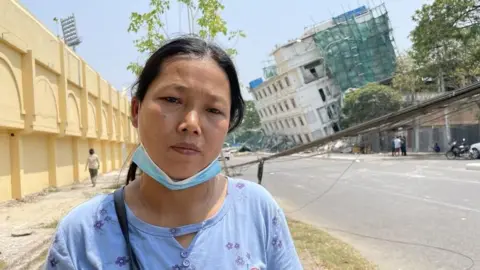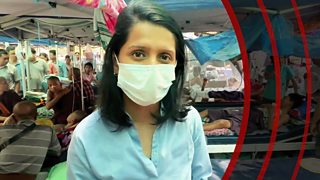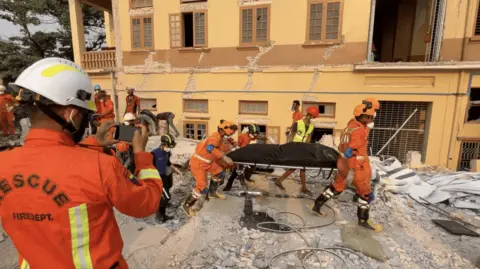Warning: This article contains details and images that some readers may find distressing
Driving into Mandalay, the massive scale of the destruction from last Friday’s earthquake revealed itself bit by bit.
In nearly every street we turned into, especially in the northern and central parts of the city, at least one building had completely collapsed, reduced to a pile of rubble. Some streets had multiple structures which had come down.
Almost every building we saw had cracks running through at least one of its walls, unsafe to step into. At the main city hospital they’re having to treat patients outdoors.
Myanmar’s military government has said it’s not allowing foreign journalists into the country after the quake, so we went in undercover. We had to operate carefully, because the country is riddled with informers and secret police who spy on their own people for the ruling military junta.
What we witnessed was a people who had very little help coming their way in the face of this massive disaster.
“I have hope that he’s alive, even if it’s a small chance,” said Nan Sin Hein, 41, who’s been waiting on the street opposite a collapsed five-storey building, day and night for five days.
Her 21 year-old-son Sai Han Pha was a construction worker, renovating the interiors of the building, which used to be a hotel and was being turned into an office space.

“If they can rescue him today, there’s a chance he’ll survive,” she says.
When the 7.7 magnitude earthquake struck, the bottom of the building sank into the ground, its top lurching at an angle over the street, looking like it could tip over at any minute.
Sai Han Pha and four other workers were trapped inside.
When we visited, rescue efforts had not even begun at the building and there was no sign they would start soon. There just isn’t enough help available on the ground – and the reason for that is the political situation in the country.

Even before the earthquake Myanmar was in turmoil – locked in a civil war that has displaced an estimated 3.5 million people. Its military has continued operations against armed insurgent groups despite the disaster.
This means that security forces are too stretched to put their full might behind relief and rescue operations. Except in some key locations, we didn’t see them in large numbers in Mandalay.
The military junta has put out a rare appeal for international aid, but its uneasy relations with many foreign countries, including the UK and the US, has meant that while these countries have pledged aid, help in the form of manpower on the ground is currently only from countries like India, China and Russia, among a few others.
And so far those rescue efforts appear to be focused on structures where masses of people are feared trapped – the high-rise Sky Villa condominium complex which was home to hundreds of people, and U Hla Thein Buddhist academy where scores of monks were taking an examination when the earthquake struck.
Neeraj Singh, who is leading the Indian disaster response team working at the Buddhist academy, said the structure had collapsed like a “pancake” – one layer on top of another.
“It’s the most difficult collapse pattern and the chances of finding survivors are very low. But we are still hopeful and trying our best,” he told the BBC.

Working under the sweltering sun, in nearly 40C, rescuers use metal drills and cutters to break the concrete slabs into smaller pieces. It’s slow and extremely demanding work. When a crane lifts up the concrete pieces, the stench of decaying bodies, already quite strong, becomes overwhelming.
The rescuers spot four to five bodies, but it still takes a couple of hours to pull the first one out.
Sitting on mats under a makeshift tent in the compound of the academy are families of the students. Their faces are weary and despondent. As soon as they hear a body has been recovered, they crowd around the ambulance it is placed in.
